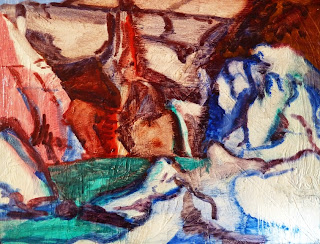 |
| 25 x 21cm Moleskin sketch book. Charcoal. |
 |
| 25cm x 19.5cm Oil on Hardboard. |
Then I made an oil painting of it using some bright colours:
65cm x 50cm Oil on linen canvas, primed with rabbit skin glue and oil primer. |
That was the end of the painting for the moment.
In July 2012 I went to the UK to visit my family and went to see my teacher, Richard Webb for a tutorial. He looked through my pictures and made a comment on this painting saying how much he liked it. I too, liked that particular picture but as it was 'half finished' and had left it, was quite surprised by his comment.
When I got back to Mauritius, in July, I kept thinking about the picture, so took it out and decided to make some small colour plays of it. I took my new pigments, oil, glass palette, the whole lot, and a very large canvas too and went to paint with a friend. These 4 paintings are what I did all on one day:
 |
| Oil on MDF 20.3 x 19.5cm |
 |
| Oil on MDF 20.3 x 19.5cm |
 |
| Oil on MDF 20.3 x 19.5cm |
 | ||||||||
| 107cm x 89cm Oil on linen, primed with rabbit skin glue and oil primer |
I posted it onto Plein Air Artists website http://pleinairartists.ning.com and made a comment about not liking some parts of it. I had been looking and admiring Thomas Wezwick's work so decided to have another go at the picture using bigger brush strokes and using all of my studies rather than just enlarging the small sketch. The artists who inspire me at the moment are: Wolf Khan, Chiam Soutine, and Paul Wonner. It was the messiness and huge brush strokes that I loved.
I also tried not to 'copy' the smaller sketches, but to let the painting tell me what to do. I was aware that I wasn't doing this enough when painting big pictures, so I kept my eyes in front and tried to feel what to do, and it worked.
This is what I produced, it was painted over the picture above, I had no idea that it would change so much:
 | |||
| 117 x 89cm (34 x 42") Home made oils on Linen, primed with rabbit skin glue and oil primer | . |
I was aware I was expressing myself emotionally at the time, something I haven't done before. I worked in a fast fury in the evening from 9 till 1.30am, I was totally transported! I find it easier to work at night when the house is quiet and all the housework jobs are done. I appreciate it is very hard for women to paint at home, and little tricks like this: painting early morning or late evening, going to paint with a friend, or having a friend come to paint with you are very important and help us to concentrate and work.
In Khan's book by Justin Spring he says "This intuitive interpenetration of forms and space is one of the most personal features of an artist's method of composition, standing in stark opposition to the mechanical and experientially false system of linear perspective, which both the impressionists and Cezanne had rejected. The new sense of spacial recession, achieved with colour, became an indispensable part of Kahn's vocabulary." I feel I am doing this, it is space and form, interpreted by colour that are my major sources of inspiration. I feel colour for definite parts of my paintings when looking at the landscape. This has always amazed me. When I go back again to a place and carry on a painting, I will pick exactly the same colour for a particular part without looking at the canvas first.
I feel it important to explain how a painting takes a long time to develop, slowly in it's own time, over a matter of months. I wait for the painting to tell me what to do and it does. I am in the dark all the time, not even aware that I am building the blocks of a painting, until it comes together at the end. I just keep doing what I feel I should be doing, whether it's going out to paint on location or working from sketches. I can also leave it for a while, travel for example and do sketches there, then will carry on when back, not interrupted by the break.
I hope that by explaining this I will help other artists in their search for the needle in the haystack, and encourage them not to stop looking, they will find it! It's not the end result or the taking part that is important, but the journey of discovery.
No comments:
Post a Comment